
Introduction and design
Knock it for its USB Type-C port. Bash it for its wimpy horsepower. But don’t even try to deny that Apple’s new MacBook is one of the most attractive, impressively-engineered laptops that the world has ever seen – there’s simply nothing quite as slick out there.
Even though it combines the portability of Apple’s MacBook Air with the Retina MacBook Pro’s high pixel-density Retina display, the new MacBook doesn’t resemble either product line – or Apple’s older, polycarbonate white MacBook of the same name, for that matter.
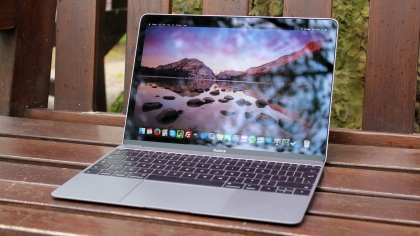
Instead, it feels like an entirely new species of otherworldly laptop that has more in common with an iPad Air than a ThinkPad. Flip open the lid, and you’re transported into the best-looking OS X Yosemite playground yet – one that goes wherever you go.
But it’s far from perfect: the new MacBook’s sole USB Type-C port and moderately-powered Intel Core M processor mean that many of this playground’s games are off-limits, and while some will find its unique keyboard more fun than a revolving roundabout, it will make others sick with frustration.
Divisive and sickly sweet, the new MacBook is the notebook equivalent of Marmite. Personally, I love the stuff (and like the new MacBook a lot), but whether it’s for you depends on how much you’re prepared to compromise.
On the catwalk
Two qualities stand out above all else when it comes to the new MacBook: thin and lightweight. Apple has managed to squeeze its components into an incredible aluminium body that measures just 0.35cm at its thinnest point and 1.31cm at its thickest.
Its thinness is in part due to Intel’s fanless Core M CPU, which is passively cooled and runs whisper quiet. There’s no fan inside, which enabled Apple’s engineers to make its chassis slimmer. The new MacBook is an ideal option if you’re frequently sharing a room with light sleepers – particularly compared to noisier, fan-based notebooks sporting Intel’s Core-series chips.
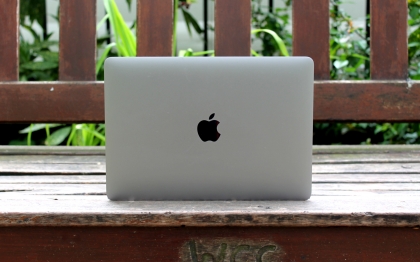
Another factor that’s helped Apple achieve the new MacBook’s svelte dimensions is its dramatically thinner keyboard, which uses an Apple-designed butterfly mechanism instead of a traditional scissor type underneath the keys.
And while we’re on the topic of thin, the new MacBook’s bezel is slimmer than ones on previous MacBooks and is complemented by a matte strip along the bottom that bears the MacBook logo. It’s available in three colors: Space Grey, Silver and Gold.
Cost and competition
Everything about the new MacBook’s design screams premium, which is what you’re shelling out for at the end of the day – you can almost forget what’s housed inside.
Of course, we’ve been here before. The original MacBook Air, which was more portable than other notebooks at the time but came with fewer ports, cost an arm and a leg when it first came out – and history has repeated itself with the new MacBook.
Starting at £1,049 (US$1,299 or AUS$1,799), the entry-level MacBook comes with 256GB of flash storage and is powered by a 1.1GHz (Turbo Boost to 2.4GHz) dual-core Intel Core M flash storage, 8GB of RAM and Intel HD Graphics 5300. Rising to £1,299 (US$1,599 or AUS$2,199), the top-end model comes with a slightly faster 1.2GHz chip (Turbo Boost up to 2.6GHz) and a 512GB SSD.
![]()
The nearest alternative price-wise is Apple’s less portable but more capable 13-inch MacBook Pro with Retina that starts at £999 (US$1,299 or AUS$1,799). That gets you a 2.7GHz (Turbo Boost to 3.1GHz) dual-core Intel Core i5 CPU, 8GB of RAM, 128GB flash storage and Intel Iris Graphics 6100.
If you’re not too bothered about a Retina display, the top-end 13-inch MacBook Air costs the same price and comes with a 1.6GHz dual-core Intel Core i5 CPU (Turbo Boost up to 2.7GHz), Intel HD Graphics 6000, 4GB of memory and 256GB flash storage.
If you’re in the Windows camp, the number of Core M-powered alternatives are growing all the time. Of those, the Lenovo Yoga 3 Pro, Asus T300 Chi and Asus UX305 share the new MacBook’s traits of slimness and portability. And if you wait a little longer, it’s possible that there may be a new contender in the shape of the Microsoft Surface Pro 4.
Specifications and features
While the 13-inch MacBook Air (which weighs 2.96 pounds) never exactly felt unwieldy in the hand, being almost a pound lighter means that the new MacBook (2.03 pounds) is on a different level of portability.
The difference in weight between the 11-inch MacBook Air (2.38 pounds) is more subtle; while it’s noticeable holding each device in a hand, you’re unlikely to tell the difference between the two when they’re slung into a backpack.
Taking a peek at the new MacBook’s Windows 8.1-powered contenders, the Asus UX305 (2.64 pounds) and the Yoga 3 Pro (2.62 pounds) lie somewhere in-between the new MacBook and the 13-inch MacBook Air. The UX305 wins the gong for being the model with the lowest height, measuring 12.3mm, followed by the Yoga 3 Pro’s 12.8mm.
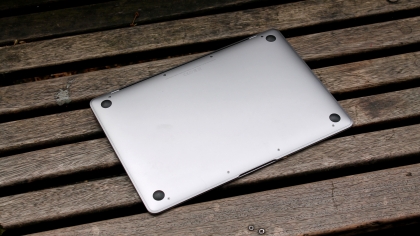
Although the new MacBook is a whisker taller than the Yoga 3 Pro at 13.1mm, that’s when measured from the tallest point at the back. Thanks to its tapered design, it measures just 3.5mm at the front and is easy to open with one hand thanks to a cutaway at the front.
At 280 x 197 x 13.1 mm (W x D x H), the new MacBook has the smallest footprint of the three, versus the UX305 (324 x 226 x 12.3), Yoga 3 Pro (330 x 228 x 12.8) and 13-inch MacBook Air (325 x 227 x 17mm), making it the clear winner if you’re a frequent traveller requiring that inch or two of extra space on the plane or train.
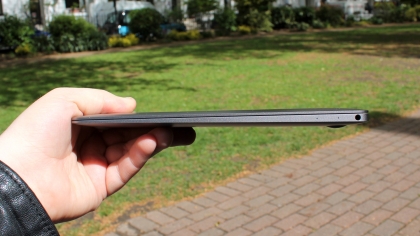
Here is the configuration of the review model supplied to TechRadar:
Spec sheet
- Processor: 1.1GHz dual-core Intel Core M CPU (Turbo Boost up to 2.4GHz) with 4MB shared L3 cache
- Operating System: OS X Yosemite
- Memory: 8GB of 1600MHz DDR3
- Display: 12-inch LED-backlit IPS display
- Graphics: Intel HD Graphics 5300 (video support up to 3,840 x 2,160)
- Storage: 256GB PCIe-based onboard flash storage
- Camera: 480p FaceTime camera
- Networking: 1/10/1000BASE-T Gigabit Ethernet
- Connectivity: 802.11ac Wi-Fi; Bluetooth 4.0
- Audio: Stereo speakers; Dual microphones; headphone port (support for Apple iPhone headset with remote and microphone)
- Dimensions: 28.05 cm / 0.35 – 1.31 cm / 19.65 cm (H x W x D)
- Weight: 0.92kg (2.03 pounds)
- Battery: Built-in 39.7-watt-hour lithium-polymer battery
Wave goodbye to full-size USB 2.0 ports, and the MagSafe adapters that juiced Apple’s old MacBooks, because both have been replaced with a single USB Type-C port on the new MacBook’s left-hand edge.
That’s right: there are no other USB ports or video outputs to be found – including Apple’s own Thunderbolt port. The absence of MagSafe is also disappointing. It was nice to know that you could wrap your leg around the power chord without sending your MacBook flying into the air.
Unlike MagSafe, which came out easily (which was the whole point), the USB Type-C connector feels uncharacteristically snug. If we’re scraping the barrel to look for a positive, using the MagSafe adapter with the cord at full length meant that it had a tendency to fall out, whereas once a USB-C charger is inserted, it’s rock solid. Plus, like Apple’s Lightning connector it works both ways around.
Oh, forget it: let’s hope a USB Type-C MagSafe adapter is invented soon.
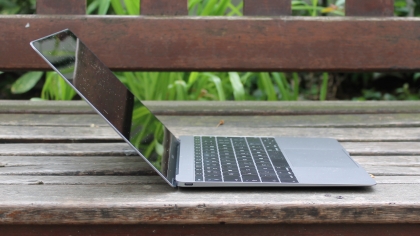
On a practical level, the change to USB Type-C is the bigger issue as it means that you’ll have to connect USB peripherals and monitors using a USB Type-C adapter, which Apple and other vendors supply. You can pick up a USB-C-to-USB-A adapter or a Multi-port adapter that lets you connect another USB-C device, a USB-A device and VGA or HDMI-equipped external monitor.
For writing this review, I used a USB Type-C Multi-port adapter with a VGA connection to hook up a 1080p monitor, inserting a USB mouse into the empty USB-A slot and hooked up the USB-C power supply to complete the adapter’s trio of connections.
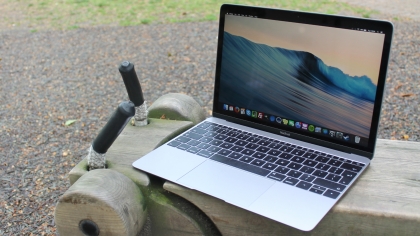
Did it annoy me? Well – not really. It felt tidy and practical and certainly wouldn’t prove a dealbreaker to buying a new MacBook. Of course MagSafe would be better, as would more ports, but it wasn’t quite the hair-tearing experience I was expecting. The obvious drawback is that the adapters aren’t free.
If you’re thinking about prying the new MacBook open and switching that pesky USB-Type C port for the old traditional one, well – you can’t. Sorry. In fact, the whole device is incredibly difficult to upgrade, as the guys at iFixit found out in their teardown, rating the new MacBook a measly 1 out of 10 for upgradability.
Bundled software
One of the positives of buying any MacBook is that it comes with a slew of free Apple software, most of which is of an excellent quality and far from the bloatware your might run into on Windows machines – and Apple’s apps look even better on the new MacBook thanks to its high-resolution display.
It currently ships with OS X Yosemite, undoubtedly the prettiest version of OS X yet – and future upgrades are bound to be free.
Plus, Apple’s Mac App Store has come on in leaps and bounds in recent years, proving an excellent resource with frequent recommendations on apps in multiple categories – such as Games, Productivity, Writing, Navigation and more. Here’s every app you’ll find upon booting up a New MacBook for the first time:
- iPhoto
- iMovie
- GarageBand
- Pages
- Numbers
- Keynote
- Maps
- iBooks
- Safari
- Facetime
- Messages
- Calendar
- Contacts
- Time Machine
- Photo Booth
- Mac App Store
- iTunes
- Game Centre
- Preview
- Notes
- Reminders
Performance and benchmarks
The new MacBook’s Intel Core M CPU is adequate for handling daily computing tasks – such as browsing the internet, streaming audio and 1080p video and multi-tasking with several browsers open with up to 10 to 15 tabs each. It can’t quite match the power of Intel’s Core i3, i5 and i7 processors, but it does allow the new MacBook to run silently. Plus, it’s mostly cool with the exception of a section along the right-hand side of the base that occasionally gets hot under heavy load.
You certainly won’t be able to escape the odd bit of slowdown when you start to run 10 or more apps in addition to a ton of browser tabs. After that point, I would find that tasks such as clicking on Google Drive to open its preferences pane, or moving a Firefox window to a different monitor can cause apps to fill with white or black color and freeze, motionless, before springing back into life.
I actually found that, when using it from day-to-day, the new MacBook felt more responsive overall than my 2014 MacBook Air, which is likely down to it having 8GB of RAM, rather than the MacBook Air’s 4GB. On the other hand, tasks that required the MacBook to do any sort of heavy lifting, such as using Gimp to scale the 60MB (or so) images that I took for this review up or down, took anything from 10 to 15 seconds longer than the Air.
Given that editing images is a vital but infrequent task that I need to carry out, the longer scaling and export times were well worth the trade off to get the new MacBook’s svelte build and impressive display.
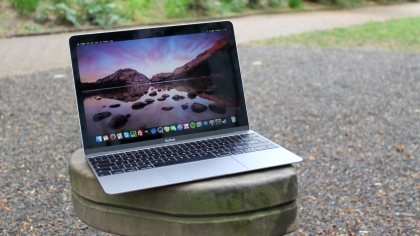
Benchmarks
- Xbench: Overall: 314.66; CPU: 202.72
- Cinebench R15 (CPU) Single Core: 98cb; Multi Core: 209 cb; Open GL: 19.05 fps
- Unigine Heaven 4.0 Medium Quality (1,680 x 1,050): Score: 219; FPS: 8.7
- Unigine Heaven 4.0 Ultra Quality (1,680 x 1,050): Score: 153; FPS: 6.1
- NovaBench: Score: 500; Graphics: 29
- Batman: Arkham City: Minimum 13 , maximum 25, average 19, 1440 x900
- Tomb Raider: Medium quality, minimum 6fps, maximum 11.7, average 8.7
- Geekbench 3 (Single Core): 2,299; (Multi Core): 4,423
- Battery life (looping HD video over Wi-Fi, three-quarter brightness): 7 hours and 5 minutes
But make no bones about it: the new MacBook is no powerhouse, and that’s reflected in the benchmarks. With a Geekbench 3 score of 4,423 on the Multi-Core test, its CPU came out 46% slower than the dual-core 2.7GHz Core i5 chip in the early 2015 Retina MacBook Pro.
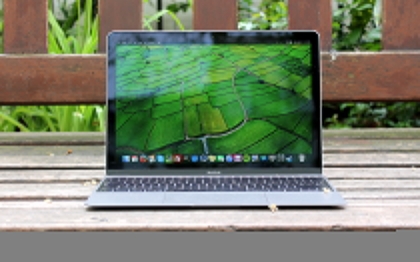
While that may not come as a huge shock, it was also soundly beaten by the top-end 11- and 13-inch MacBook Air models from earlier this year, which attracted an average Geekbench user score of 8,947 and 6,828, respectively. If you’re looking to use a MacBook for regularly editing image files or editing or converting video, those MacBook Airs both cost less than the new MacBook and would be far more suitable while remaining plenty portable.
The new MacBook’s graphical grunt was nowhere to be found due to the inclusion of Intel’s integrated graphics. Both Batman: Arkham City and Tomb Raider mustered low frames per second scores that would make either game unplayable.
Display
Here it is: the highlight of the new MacBook. The display is one of the best I’ve seen on a notebook, with incredibly rich colors and excellent 170-degree viewing angles.
Measured with our X-Rite colorimeter, it notched up a brightness level of 375.15cd/m2, which easily proved bright enough to see indoors and was just about good enough to read websites in bright sunlight too – even if videos were a little harder to follow.
Elsewhere, the MacBook produced decent black levels of 0.33 cd/m2 black levels, with color accuracy standing at 91.3% of the sRGB color gamut. While it’s not quite high enough for media professionals, you probably won’t notice the difference. The display’s inky blacks and bold colours make text and images ‘pop’ on the impressive display – and once you’ve seen it, it’s so, so hard to go back to a MacBook Air.
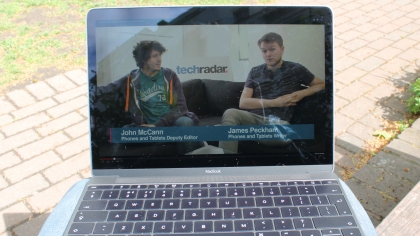
There’s another advantage to that 2,304 x 1,440 pixel-resolution display: you can scale it up to get more desktop space and go far beyond Apple’s default scaled resolutions.
By adding a custom resolution, I managed to soar all the way up to 1,920 x 1,080 in High-DPI mode using SwitchResX, which allowed me to see the same amount of spreadsheet rows and columns as a 27-inch monitor. Sure the text was tiny, but I could still make out the numbers and edit the spreadsheet without any trouble.
I might not be doing it all the time, but compared to my old setup, which was an 11-inch MacBook AIr connected to a portable USB DisplayLink monitor, I now have enough desktop real-estate to switch to see more on the screen at the same time. Sure, that’s been possible on high-resolution Windows and Apple machines for some time, but having all that desktop space is even more impressive on a titchy 12.1-inch machine as thin as a pencil.
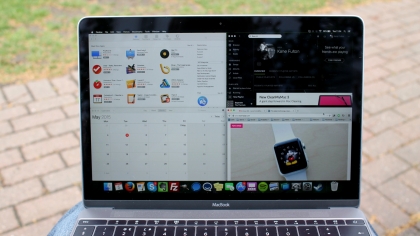
The new MacBook’s stereo speakers are one the of the surprising highlights of the new MacBook. It’s incredible what Apple has managed to do in that department. Located on the top of the base under the bezel, they’re pleasingly punchy with good mid-range tones, even if the bass is predictably lacking. They’re loud, too, for the size – and sound far better than the 11- and 13-inch MacBook Air’s comparitively tinny speakers.
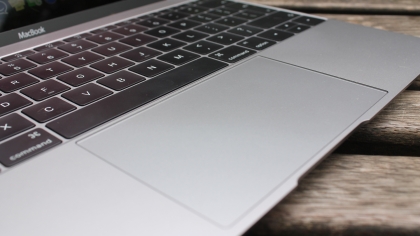
The new MacBook uses a new Force Touch trackpad that adds an extra click using haptic feedback. That means there’s no mechanical construction under the trackpad, instead using haptic feedback to let you indicate where abouts on the trackpad the click takes place.
Initially I found that the larger trackpad size actually made me accidentally miss the right-click zone more often than I did on the 11-inch MacBook Air (which was never). However, after some practice I soon got used to the larger trackpad, which has tons of potential once developers get to grips with Yosemite’s Force Touch Trackpad API (or application programming interface).
The new MacBook has good, but not excellent battery life, ekeing out 7 hours and 5 minutes from its 39.7Wr battery on our looping video test over Wi-Fi. That’s not quite post-Haswell MacBook Air levels of battery life longevity, but it isn’t far off Apple’s older Ivy Bridge models. Still, that Retina display has to draw oodles of power from somewhere, and if you need the best battery life in a MacBook you can get, the new MacBook is not the way to go.
Keys to the heart
Apple has completely redesigned the new MacBook’s keyboard, which now uses a new Butterfly hinge rather than the scissor switch under each key. The keys are still backlit, only now they have individual lighting zones that prevents light from bleeding between the keys – and you get fewer crumbs dropped between them, too.
The changes make the keyboard by far the most divisive feature of the new MacBook – and it took me a week to get fully used to it after using an 11-inch MacBook Air for five years.
Initially I couldn’t quite type as fast as I could on the MacBook Air, but the reduced amount of pressure needed to make each key actuate makes the New MacBook’s keyboard slightly more comfortable for typing on for hours at a time. Like me, once you get used to it, you’ll find yourself flying.
Verdict
The New MacBook is the future, but it isn’t for everyone just yet. The lack of USB ports and the need to buy an adapter (if you have peripherals and a monitor) will likely be the first dealbreaker, followed by its price. If you’re still onboard after those potential pitfalls, the new MacBook is one of the most luxurious, compact and fun notebooks to use today.
We liked
After witnessing the Retina MacBook Pro’s display, it was always likely that the new MacBook would have a stunning display – and it doesn’t disappoint. Great viewing angles and bold colors make it one of the best we’ve seen in a laptop. It’s all part of a brilliantly portable package that’s the closest a laptop has come yet to offering the portability of a tablet (well, an iPad).
The new MacBook’s speakers gave surprisingly full-bodied sound that won’t shake the room but make for a far more pleasant listening experience than Apple’s previous MacBook Air or MacBook Pro models. While many will sit on the fence when it comes to the keyboard, my experience with it only got better in time – and I ended up preferring it to the MacBook Air’s after almost two weeks.
It’s a similar scenario with the Force Touch Trackpad, which felt a little alien at first but became more comfortable over time.
We disliked
The new MacBook is far from a monster under the hood. However, if you can get over the fact that it’s designed for anything from browsing the internet to light image editing, streaming video and music to other light computing tasks, it should perform OK for what you want it to do.
Bear in mind that you will need to pay for at least one of several USB Type-C adapters out there to use your existing peripherals and monitors. Some say that’s just the price to pay for being an early adopter, but it could be hard for you to stomach considering its already high starting cost.
Final verdict
The decision of whether you should buy a new MacBook is a simple one: does it play to your strengths? Perhaps you need the lightest and most portable OS X machine out there today, one with good battery life. Maybe you appreciate an incredible, vibrant display that’s equally as good at rendering your crisp documents as it is displaying the same amount of a spreadsheet as a 24-inch monitor.
Maybe, just maybe, you travel a lot and play music out of your laptop’s speakers. But – and it’s a big but – you need to be prepared to put up with its pitfalls. Don’t expect to crunch through major mulittasking without slowing down. And you may end up merely coping with its keyboard rather than falling in love with it. You’ll definitely have to put up with at least one adapter if you want to use any peripherals or an external monitor.
Like in any relationship, the one between you and your MacBook will be frought with compromises. But if it’s meant to be, then you will be prepared to make them. If you’re not, you can always take it back to the Apple store to save yourself a messy divorce. In other words: if possible, try before you buy.
![]()
Related Posts
December 6, 2021
7+ Web Design Trends for 2022: Which Will You Use?
December 6, 2021
The 10 Best WordPress Booking Plugins to Use On Your Website
December 6, 2021
How to Use a Web Cache Viewer to View a Cached Page
November 6, 2021
10 Modern Web Design Trends for 2022
November 6, 2021
Best Free SSL Certificate Providers (+ How to Get Started)
November 6, 2021
How to Design a Landing Page That Sends Conversions Skyrocketing
November 6, 2021
What Are the Best WordPress Security Plugins for your Website?
October 6, 2021
Your Guide to How to Buy a Domain Name
October 6, 2021
How to Build a WordPress Website: 9 Steps to Build Your Site
September 6, 2021
10 Best Websites for Downloading Free PSD Files
September 6, 2021
HTML5 Template: A Basic Code Template to Start Your Next Project
September 6, 2021
How Much Does It Cost to Build a Website for a Small Business?
September 6, 2021
A List of Free Public CDNs for Web Developers
September 6, 2021
6 Advanced JavaScript Concepts You Should Know
August 6, 2021
10 Simple Tips for Launching a Website
August 6, 2021
25 Beautiful Examples of “Coming Soon” Pages
August 6, 2021
10 Useful Responsive Design Testing Tools
August 6, 2021
Best-Converting Shopify Themes: 4 Best Shopify Themes
July 6, 2021
What Is Alt Text and Why Should You Use It?
July 6, 2021
24 Must-Know Graphic Design Terms
June 6, 2021
How to Design a Product Page: 6 Pro Design Tips
April 6, 2021
A Beginner’s Guide to Competitor Website Analysis
April 6, 2021
6 BigCommerce Design Tips For Big Ecommerce Results
April 6, 2021
Is WordPress Good for Ecommerce? [Pros and Cons]
March 6, 2021
Make Websites Mobile-Friendly: 5 Astounding Tips
March 6, 2021
Shopify vs. Magento: Which Platform Should I Use?
March 6, 2021
Top 5 Web Design Tools & Software Applications
February 6, 2021
Website Optimization Checklist: Your Go-To Guide to SEO
February 6, 2021
5 UX Design Trends to Dazzle Users in 2021
February 6, 2021
What Is the Average Page Load Time and How Can You Do Better?
February 6, 2021
Choosing an Ecommerce Platform That Will Wow Customers
February 6, 2021
7 Best Practices for Crafting Landing Pages with Forms
February 6, 2021
7 B2B Web Design Tips to Craft an Eye-Catching Website
January 6, 2021
Mobile-Friendly Checker | Check Your Site’s Mobile Score Now
January 6, 2021
8 Tips for Developing a Fantastic Mobile-Friendly Website
December 6, 2020
How to Add an Online Store to Your Website [4 Ways]
December 6, 2020
5 UX Design Tips for Seamless Online Shopping
November 6, 2020
Ecommerce Website Essentials: Does Your Site Have All 11?
November 6, 2020
5 Small Business Website Essentials You Need for Your Site
November 6, 2020
Your Website Redesign Checklist for 2020: 7 Steps for Success
May 1, 2020
Psychology of Color [Infographic]
April 21, 2020
How to start an online store that drives huge sales
January 3, 2020
5 Lead Generation Website Design Best Practices
March 6, 2019
6 Reasons You Should Redesign Your Website in 2019
March 6, 2019
7 Web Design Trends for 2019
February 19, 2019
Who owns the website/app source code, client or developer
February 7, 2019
Don’t Let Your Domain Names Expire in 2019
January 8, 2019
2019 Website Development Trends To Note
October 6, 2017
How Web Design Impacts Content Marketing
October 6, 2017
How to Choose a Navigation Setup
August 6, 2017
Why User Experience Matters to Marketing
July 6, 2017
5 Ways Web Design Impacts Customer Experience
September 6, 2016
How to Learn Angular
September 6, 2016
The Excuses for Not Having a Website (Infographic)
September 6, 2016
How to Build an Award-Winning Web Design Team
September 6, 2016
13 Free Data Visualization Tools
August 6, 2016
How Selling Pastries Helped Us Design a Better Product
August 6, 2016
11 Sites to Help You Find Material Design Inspiration
July 4, 2016
How to change free wordpress.com url
April 6, 2016
The 5 Best Free FTP Clients
April 6, 2016
7 Free UX E-Books Worth Reading
March 6, 2016
Can Handwritten Letters Get You More Clients?
December 10, 2015
Star Wars Week: How to create your own Star Wars effects for free
December 6, 2015
20 "Coming Soon" Pages for Inspiration
December 6, 2015
6 Free Tools for Creating Your Own Icon Font
December 6, 2015
9 Useful Tools for Creating Material Design Color Palettes
November 6, 2015
20 Free UI Kits to Download
November 6, 2015
50 Web Designs with Awesome Typography
November 6, 2015
When to Use rel="nofollow"
November 6, 2015
7 Free Books That Will Help You Become More Productive
November 6, 2015
50 Beautiful One-Page Websites for Inspiration
November 6, 2015
Circular Images with CSS
October 6, 2015
Lessons Learned from an Unsuccessful Kickstarter
October 6, 2015
5 Games That Teach You How to Code
October 6, 2015
Cheatsheet: Photoshop Keyboard Shortcuts
October 6, 2015
An Easy Way to Create a Freelance Contract for Your Projects
October 6, 2015
50 Design Agency Websites for Inspiration
September 29, 2015
JB Hi-Fi shutting the book on ebooks
September 24, 2015
Opinion: Quick, Quickflix: It's time to give yourself the flick
September 24, 2015
New Star Wars 360-degree video is among first on Facebook
September 21, 2015
Apple purges malicious iPhone and iPad apps from App Store
September 12, 2015
Apple's new Live Photos feature will eat up your storage
September 12, 2015
The latest Windows 10 Mobile preview has been delayed
September 12, 2015
IBM buys StrongLoop to add Node.js development to its cloud
September 8, 2015
Fake Android porn app takes your photo, then holds it ransom
September 6, 2015
50 Restaurant Websites for Inspiration
September 6, 2015
Zero UI — The Future of Interfaces
September 6, 2015
50 Beautiful Websites with Big Background Images
September 6, 2015
Infographic: 69 Web Design Tips
September 6, 2015
Free Windows 10 Icons
September 2, 2015
Instagram turns itself into a genuine messaging service
August 11, 2015
In Depth: How Microsoft taught Cortana to be more human
August 11, 2015
Windows 10 price, news and features
August 11, 2015
Windows 10's broken update introduces endless reboot loop
August 11, 2015
Windows 10 races to 27m installs
August 11, 2015
Windows 10 IoT Core gets first public release
August 10, 2015
iOS Tips: How to backup iPhone to an external drive
August 10, 2015
Windows 8.1 RT finally getting Windows 10 Start Menu
August 10, 2015
How to use Windows Hello
August 10, 2015
Review: Moto Surround
August 10, 2015
Review: Moto G (2015)
August 9, 2015
8 of the best free VPN services
August 8, 2015
Use Firefox? Mozilla urges you update ASAP
August 7, 2015
Mac Tips: Apple Mail: How to remove the Favorites Bar
August 7, 2015
How to make the OS X dock appear faster
August 7, 2015
Review: BQ Aquaris E45 Ubuntu Edition
August 7, 2015
Review: Acer Liquid Jade Z
August 6, 2015
How to reinstall Linux
August 6, 2015
How to reinstall Windows
August 6, 2015
Updated: Apple Music: release date, price and features
August 6, 2015
Social News Websites for Front-End Developers
August 6, 2015
10 Free JavaScript Books
August 6, 2015
50 Beautiful Blog Designs
August 6, 2015
Animated SVG Pipes Effect
August 6, 2015
Launching Your First App
August 5, 2015
Windows 10 goes freemium with paid apps
August 5, 2015
Updated: Week 1 with Windows 10
August 5, 2015
Mac Tips: How to manage Safari notifications on Mac
August 5, 2015
Microsoft Sway may kill the PowerPoint presentation
August 4, 2015
Microsoft gives Outlook on the web a new look
August 4, 2015
Mac OS X vulnerable to new zero-day attack
August 4, 2015
Windows 10 users warned of two scams
August 4, 2015
Microsoft's Docs.com is now available to everyone
August 3, 2015
Mac Tips: How to edit the Favorites sidebar on Mac
August 3, 2015
Updated: Windows 10 price, news and features
July 29, 2015
Review: HP ProDesk 405 G2
July 29, 2015
Hands-on review: HP Elite x2 1011
July 29, 2015
Hands-on review: Updated: Windows 10 Mobile
July 29, 2015
Review: Updated: Nvidia Shield Android TV
July 28, 2015
LIVE: Windows 10 launch: Live Blog!
July 28, 2015
How to prepare for your upgrade to Windows 10
July 28, 2015
Review: Updated: Windows 10
July 28, 2015
Review: Updated: HP Pro Tablet 608
July 28, 2015
Review: Heat Genius
July 28, 2015
Hands-on review: Moto X Play
July 28, 2015
Hands-on review: Moto X Style
July 28, 2015
Hands-on review: Moto G (2015)
July 28, 2015
Review: 13-inch MacBook Air (early 2015)
July 28, 2015
Hands-on review: OnePlus 2
July 28, 2015
Review: LG 65EG960T 4K OLED
July 28, 2015
Mac Tips: How to share printers on Mac
July 27, 2015
Apple Music's arrival hasn't opened Pandora's box
July 26, 2015
Review: Garmin Swim
July 25, 2015
How to merge OS X contacts into an existing list
July 25, 2015
Hands-on review: UPDATED: ZTE Axon
July 24, 2015
Mac Tips: How to zoom in on a Mac
July 24, 2015
What Windows 10 means for the enterprise
July 24, 2015
Review: JBL Charge 2 Plus
July 24, 2015
Review: Acer Aspire S7
July 24, 2015
Review: Updated: Canon G3 X
July 24, 2015
Review: Updated: iPad Air 2
July 24, 2015
Review: Thinksound On1
July 24, 2015
Review: Asus Chromebook Flip
July 24, 2015
Review: Garmin Forerunner 225
July 23, 2015
Review: Garmin nuvi 68LM
July 23, 2015
Review: Samsung Galaxy S6 Active
July 23, 2015
Review: Bowers and Wilkins P5 Wireless
July 23, 2015
Review: Dell XPS 15 (2015)
July 21, 2015
Review: Fuji S9900W
July 21, 2015
Review: Updated: Fitbit Surge
July 21, 2015
Review: UE Roll
July 21, 2015
Hands-on review: Ubik Uno
July 20, 2015
Review: Samsung HW-J650
July 20, 2015
Updated: 40 best Android Wear smartwatch apps 2015
July 20, 2015
Review: Acer Chromebook C740 review
July 20, 2015
Review: Huawei Talkband B2
July 20, 2015
Review: Dell Venue 10 7000
July 20, 2015
Review: Intel Core i7-5775C
July 17, 2015
Mac Tips: How to delete locked files on Mac
July 17, 2015
Review: Pebble Time
July 16, 2015
Microsoft just made Windows XP even less secure
July 16, 2015
Windows 8.1 RT is getting an update this September
July 16, 2015
OS showdown: Windows 10 vs Windows 8.1 vs Windows 7
July 16, 2015
Review: Acer CB280HK
July 15, 2015
Windows 10 is ready for new laptops and PCs
July 15, 2015
Explained: How to take a screenshot in Windows
July 15, 2015
Office for Windows 10 appears in latest build
July 14, 2015
Review: ZTE Axon
July 14, 2015
Review: ViewSonic VP2780-4K
July 14, 2015
Hands-on review: SanDisk Connect Wireless Stick
July 14, 2015
Review: Oppo PM-3
July 14, 2015
Review: BT 11ac Dual-Band Wi-Fi Extender 1200
July 14, 2015
Review: Fuji X-T10
July 13, 2015
How to build an SEO strategy for your business
July 13, 2015
Review: Lenovo ThinkPad Yoga 15
July 13, 2015
Review: Audio-Technica ATH-MSR7
July 13, 2015
Review: Garmin NuviCam LMT-D
July 13, 2015
Review: Dell Inspiron 13 7000
July 13, 2015
Hands-on review: AstroPi SenseHAT
July 13, 2015
Hands-on review: EE Rook
July 13, 2015
Hands-on review: Updated: HTC Vive
July 12, 2015
Here's the ultimate software list for PC fanatics
July 10, 2015
How to use the new Photos app for Mac
July 10, 2015
Windows 10 Insider Preview Build 10166 available now
July 10, 2015
Splunk spends big on cybersecurity acquisition
July 10, 2015
Making Windows 10 apps just got a whole lot easier
July 10, 2015
Review: Lenovo LaVie Z 360
July 9, 2015
OS X El Capitan public beta available right now
July 9, 2015
Microsoft finally unveils Office 2016 for Mac
July 9, 2015
Review: Updated: Chromecast
July 9, 2015
Review: Updated: Tesco Hudl 2
July 9, 2015
Review: Lenovo ThinkPad E550
July 9, 2015
Review: Updated: Google Nexus 6
July 8, 2015
What you need to know about Windows Server 2016
July 7, 2015
Microsoft to hike enterprise cloud pricing
July 6, 2015
Hacking Team end up being totally 0wned
July 6, 2015
Review: HP Pro Slate 12
July 6, 2015
Review: Samsung 850 Pro 2TB
July 6, 2015
Review: Asus RT-AC87U
July 6, 2015
Review: Jawbone UP2
July 6, 2015
Reimagining the Web Design Process
July 6, 2015
50 Clean Websites for Inspiration
July 6, 2015
15 Free Books for People Who Code
July 6, 2015
Web Storage: A Primer
July 6, 2015
A Look at Some CSS Methodologies
July 3, 2015
6 Essential Mac Mouse and Trackpad Tips
July 2, 2015
How to install a third party keyboard on Android
July 2, 2015
Review: UPDATED: Asus Zenfone 2
July 2, 2015
Review: Alienware 13
July 2, 2015
Review: HP DeskJet 1010
July 1, 2015
5 issues we want Apple Music to fix
June 13, 2015
Cortana will get its own button on Windows 10 PCs
June 12, 2015
Windows 10 will come with universal Skype app
June 12, 2015
iPad music production: 18 Best apps and gear
June 12, 2015
Windows 10 all set for early enterprise struggle
June 12, 2015
Review: Garmin VIRB Elite
June 11, 2015
Review: Updated: Nvidia Shield Tablet
June 11, 2015
Review: Nokia Lumia 635
June 10, 2015
Microsoft brings more online tweaks to Office 365
June 10, 2015
Mac Tips: How to use Screen Sharing in Mac OS X
June 9, 2015
Hands-on review: Meizu M2 Note
June 9, 2015
Hands-on review: EE 4GEE Action Camera
June 9, 2015
Review: Toshiba 3TB Canvio external hard drive
June 9, 2015
Review: Olympus SH-2
June 8, 2015
Hands-on review: Updated: Apple CarPlay
June 8, 2015
UPDATED: iOS 9 release date, features and news
June 8, 2015
Review: Updated: Roku 2
June 8, 2015
Review: Updated: PlayStation Vue
June 8, 2015
Review: Dell PowerEdge R730
June 8, 2015
Review: Canon SX710 HS
June 7, 2015
UPDATED: iOS 9 release date, features and rumors
June 7, 2015
Review: Lenovo S20-30
June 6, 2015
Free Writing Icons
June 6, 2015
15 CSS Questions to Test Your Knowledge
June 6, 2015
The Best CSS Reset Stylesheets
June 6, 2015
How CSS Specificity Works
June 5, 2015
'Delay' is a new feature in Windows 10
June 5, 2015
Review: Beyerdynamic Custom One Pro Plus
June 5, 2015
Latest SEO Marketing tools
June 5, 2015
Review: Nvidia Shield Android TV
June 5, 2015
Review: Honor 4X
June 5, 2015
Review: In Depth: Oppo R5
June 3, 2015
Hands-on review: Huawei P8 Lite
June 3, 2015
How To: How to create eBooks on a Mac
June 3, 2015
Review: Updated: Tidal
June 3, 2015
Review: Canon 750D (Rebel T6i)
June 2, 2015
Review: Updated: Asus ZenWatch
June 2, 2015
Review: Alcatel OneTouch Idol 3
June 2, 2015
Review: Updated: Nokia Lumia 1520
June 2, 2015
Review: Updated: Yotaphone 2
June 2, 2015
Review: Updated: Nokia Lumia 625
June 2, 2015
Review: Creative Muvo Mini
June 1, 2015
Review: Acer TravelMate P645 (2015)
June 1, 2015
Hands-on review: Corsair Bulldog
May 29, 2015
In Depth: NetApp: a requiem
May 29, 2015
July is looking definite for Windows 10 release
May 29, 2015
Hands-on review: Google Photos
May 28, 2015
Mac Tips: The 16 best free GarageBand plugins
May 28, 2015
Review: Canon 760D (Rebel T6s)
May 27, 2015
Review: Lenovo Yoga 3 14
May 27, 2015
Hands-on review: Serif Affinity Photo
May 27, 2015
Review: Garmin Vivoactive
May 26, 2015
Review: Datacolor Spyder5 Elite
May 26, 2015
Hands-on review: Sony Xperia Z3+
May 26, 2015
Review: Epson BrightLink Pro 1410Wi
May 26, 2015
Review: Technics Premium C700
May 26, 2015
Review: Canon EOS M3
May 26, 2015
Review: Updated: HTC One M9
May 26, 2015
Review: Updated: Sony Xperia Z3 Compact
May 25, 2015
Review: Updated: New Nintendo 3DS
May 25, 2015
Updated: 50 best Mac tips, tricks and timesavers
May 25, 2015
Updated: Windows email: 5 best free clients
May 25, 2015
Instagram is planning to invade your inbox
May 25, 2015
Review: Updated: Foxtel Play
May 24, 2015
How Windows 10 will change smartphones forever
May 24, 2015
Review: Vodafone Smart Prime 6
May 24, 2015
Review: Updated: iPad mini
May 22, 2015
Office Now may be Cortana for your work life
May 22, 2015
Review: Updated: Lenovo Yoga 3 Pro
May 22, 2015
Review: Microsoft Lumia 640 LTE
May 22, 2015
Review: Updated: Fitbit Flex
May 21, 2015
Updated: Best free Android apps 2015
May 21, 2015
Review: Asus ZenBook Pro UX501
May 21, 2015
Review: Sennheiser Momentum In-Ear
May 20, 2015
Hands-on review: UPDATED: Asus Zenfone 2
May 20, 2015
OS X 10.11 release date, features and rumors
May 18, 2015
Updated: Best free antivirus software 2015
May 18, 2015
iPhone 6S rumored to launch as soon as August
May 18, 2015
Microsoft ready to pounce and acquire IFS?
May 17, 2015
5 of the most popular Linux gaming distros
May 16, 2015
Review: Acer Chromebook 15 C910
May 16, 2015
Review: Lenovo ThinkPad X1 Carbon (2015)
May 16, 2015
Review: Polk Nue Voe
May 16, 2015
The top 10 data breaches of the past 12 months
May 16, 2015
Hands-on review: Updated: LG G4
May 16, 2015
Review: Updated: Quickflix
May 16, 2015
Review: LG Watch Urbane
May 16, 2015
Review: Razer Nabu X
May 16, 2015
Hands-on review: Updated: Windows 10
May 16, 2015
Review: UPDATED: Moto X
May 16, 2015
Review: Updated: Moto G (2013)
May 12, 2015
Review: TomTom Go 50
May 12, 2015
Review: Updated: Moto G (2014)
May 12, 2015
Review: Garmin Vivofit 2
May 12, 2015
Review: Asus Transformer Book Flip TP300LA
May 11, 2015
Review: MSI GT80 Titan
May 11, 2015
Review: Monster SuperStar BackFloat
May 9, 2015
Review: Updated: Apple Watch
May 7, 2015
5 million internet users infected by adware
May 6, 2015
Android M will be shown at Google IO 2015
May 6, 2015
Review: Epson WorkForce Pro WF-4630
May 6, 2015
Review: Master & Dynamic MH40
May 6, 2015
How to Use Gulp
May 6, 2015
Getting Started with Command-Line Interfaces
May 6, 2015
What It’s Like to Contribute to WordPress
May 6, 2015
Ultimate Guide to Link Types for Hyperlinks
May 6, 2015
11 Things You Might Not Know About jQuery
May 5, 2015
Hands-on review: Updated: PlayStation Now
May 5, 2015
Review: Lenovo ThinkPad Yoga 12
May 5, 2015
Review: Updated: iPad Air
May 5, 2015
Review: Panasonic SZ10
May 5, 2015
Review: Updated: Fetch TV
May 4, 2015
Review: Cambridge Audio Go V2
May 3, 2015
Review: Lightroom CC/Lightroom 6
May 2, 2015
5 of the most popular Raspberry Pi distros
May 1, 2015
Review: PlayStation Vue
May 1, 2015
Hands-on review: Updated: Microsoft HoloLens
April 30, 2015
Build 2015: Why Windows 10 may not arrive until fall
April 29, 2015
The biggest announcements from Microsoft Build 2015
April 29, 2015
Hands-on review: TomTom Bandit
April 29, 2015
Hands-on review: EE Harrier Mini
April 28, 2015
Review: Samsung NX500
April 28, 2015
Hands-on review: LG G4
April 28, 2015
Review: Patriot Ignite 480GB SSD
April 28, 2015
Hands-on review: EE Harrier
April 28, 2015
Review: Linx 10
April 28, 2015
Review: 1&1 Cloud Server
April 26, 2015
Hands-on review: Acer Iconia One 8
April 25, 2015
How to run Windows on a Mac with Boot Camp
April 24, 2015
Dropbox Notes poised to challenge Google Docs at launch
April 24, 2015
Hands-on review: Acer Aspire E14
April 24, 2015
Hands-on review: UPDATED: Valve Steam Controller
April 24, 2015
Review: Acer Iconia One 7
April 23, 2015
Windows 10 just revived everyone's favorite PC game
April 23, 2015
Google opens up Chromebooks to competitors
April 23, 2015
Here's how Outlook 2016 looks on Windows 10
April 23, 2015
Hands-on review: Updated: Acer Liquid M220
April 23, 2015
Hands-on review: Acer Aspire Switch 10 (2015)
April 23, 2015
Hands-on review: Acer Aspire R 11
April 22, 2015
Review: Alienware 17 (2015)
April 22, 2015
Hands-on review: Updated: HP Pavilion 15 (2015)
April 21, 2015
This is how Windows 10 will arrive on your PC
April 21, 2015
Review: iMac with Retina 5K display
April 21, 2015
Review: Epson XP-420 All-in-One
April 18, 2015
Google Now brings better search to Chrome OS
April 17, 2015
Review: Epson Moverio BT-200
April 17, 2015
Review: Pentax K-S2
April 16, 2015
Updated: Android Lollipop 5.0 update: when can I get it?
April 15, 2015
Hands-on review: Updated: Huawei P8
April 15, 2015
Review: SanDisk Ultra Dual USB Drive 3.0
April 15, 2015
Review: Updated: LG G3
April 15, 2015
Review: Updated: LG G3
April 15, 2015
Review: Crucial BX100 1TB
April 13, 2015
iOS 8.4 beta reveals complete Music app overhaul
April 13, 2015
Linux 4.0: little fanfare for a tiny new release
April 13, 2015
Achievement unlocked: Microsoft gamifies Windows 10
April 13, 2015
Best Android Wear smartwatch apps 2015
April 13, 2015
Review: Acer Aspire R13
April 12, 2015
Review: TP-Link Archer D9
April 10, 2015
Microsoft's new browser arrives for Windows 10 phones
April 10, 2015
Review: LG UltraWide 34UC97
April 9, 2015
Office now integrates with Dropbox on the web
April 9, 2015
Now you can buy video games with Apple Pay
April 9, 2015
Updated: iOS 8 features and updates
April 9, 2015
Microsoft's stripped down Nano Server is on the way
April 8, 2015
Skype Translator gets even more features
April 8, 2015
Windows mail services hit by widespread outages
April 8, 2015
Review: UPDATED: Amazon Echo
April 8, 2015
Hands-on review: Dell Venue 10 7000
April 8, 2015
Review: Updated: OS X 10.10 Yosemite
April 7, 2015
Google's GMeet could kill teleconferencing
April 7, 2015
Is Redstone the first Windows 10 update?
April 7, 2015
Next peek at Windows Server 2016 due next month
April 7, 2015
Review: Acer Aspire Switch 11
April 7, 2015
Review: Adobe Document Cloud
April 6, 2015
Hands-on review: Updated: New MacBook 2015
April 6, 2015
Freebie: 100 Awesome App Icons
April 6, 2015
Six Revisions Quarterly Report #1
April 6, 2015
A Modern Approach to Improving Website Speed
April 6, 2015
Disable Text Selection with CSS
April 4, 2015
Review: Nikon D7200
April 3, 2015
Amazon Prime video now streams to any Android tablet
April 3, 2015
Review: Google Cardboard
April 3, 2015
Review: MSI WS60
April 2, 2015
Chrome users can now run 1.3 million Android apps
April 2, 2015
See Windows 10 Mobile running on an Android handset
April 2, 2015
Review: Mini review: Macphun Noiseless Pro 1.0
April 2, 2015
Review: Intel SSD 750 Series 1.2TB
April 2, 2015
Review: BenQ TreVolo
April 2, 2015
Hands-on review: Nikon 1 J5
April 1, 2015
Microsoft launches Windows 10 music and video apps
April 1, 2015
Review: mini review: Sony XBA-H1
December 19, 2014
Review: CoPilot Premium sat nav app
December 19, 2014





























































































































































































































































































































































































































































































































































































